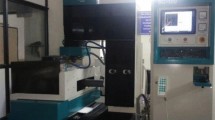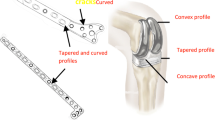Abstract
Due to increased demand of dimensional accuracy and high precision of manufactured parts, wire electrical discharge machining (WEDM) became very popular, especially for ‘difficult-to-cut’ materials like titanium alloys. Grade 5 Ti alloy (Ti–6Al–4V) has enormous application in aerospace and biomedical fields. WEDM performance of Ti–6Al–4V is somewhat restricted due to its poor thermal conductivity, formation of hard and brittle carbide-/oxide-rich layer and often surface cracking which affect fatigue performance of the part product. Therefore, multi-cut strategy is adapted to mitigate machining-induced defects. The multi-cut mode consists of one main/rough cut followed by a number of trim/finish cuts. Aspects of surface integrity of the WEDMed Ti–6Al–4V obtained in different modes of cut are delineated in this reporting. Three slots are produced: (1) main cut; (2) main cut followed by one trim cut; and (3) main cut followed by two trim cuts using uncoated brass wire and zinc-coated brass wire, respectively. Surface morphology along with topographical features including roughness average, crack density, recast layer thickness, material immigration, residual stress and micro-indentation hardness is studied. Results obtained thereof are analysed with relevance to kerf width, material removal rate and wire wear.


























Similar content being viewed by others
References
Budinski KG (1991) Tribological properties of titanium alloys. Wear 151(2):203–217
Sarkar S, Gosh K, Bhattacharyya B (2010) An integrated approach to optimization of WEDM combining single-pass and multipass cutting operation. Mater Manuf Process 25(8):799–807
Kumar J, Khamba JS (2010) Multi-response optimization in ultrasonic machining of titanium using Taguchi’s approach and utility concept. Int J Manuf Res 5(2):139–160
Kuriakose S, Shunmugam MS (2004) Characteristics of wire-electro discharge machined Ti6Al4V surface. Mater Lett 58(17–18):2231–2237
Mukherjee R, Chakraborty S, Samanta S (2012) Selection of wire electrical discharge machining process parameters using non-traditional optimization algorithms. Appl Soft Comput 12(8):2506–2516
Azhiri RB, Teimouri R, Baboly MG, Leseman Z (2014) Application of Taguchi, ANFIS and grey relational analysis for studying, modeling and optimization of wire EDM process while using gaseous media. Int J Adv Manuf Technol 71(1):279–295
Long BT, Phan NH, Cuong N, Jatti VS (2016) Optimization of PMEDM process parameter for maximizing material removal rate by Taguchi’s method. Int J Adv Manuf Technol 87(5–8):1929–1939
Azam M, Jahanzaib M, Abbasi JA, Abbas M, Wasim A, Hussain S (2016) Parametric analysis of recast layer formation in wire-cut EDM of HSLA steel. Int J Adv Manuf Technol 87(1–4):713–722
Govindan P, Joshi SS (2012) Analysis of micro-cracks on machined surfaces in dry electrical discharge machining. J Manuf Process 14(3):277–288
Dauw DF, Albert L (1992) About the evolution of wire tool performance in wire EDM. Ann CIRP 41(1):221–225
Prohaszka J, Mamalis AG, Vaxevanidis NM (1997) The effect of electrode material on machinability in wire electro-discharge machining. J Mater Process Technol 69(1–3):233–237
Liao YS, Yan MT, Chang CC (2002) A neural network approach for the on-line estimation of workpiece height in WEDM. J Mater Process Technol 121:252–258
Jangra KK (2015) An experimental study for multi-pass cutting operation in wire electrical discharge machining of WC-5.3% Co composite. Int J Adv Manuf Technol 76(5–8):971–982
Mandal A, Dixit AR, Das A, Mandal N (2016) Modeling and optimization of machining nimonic C-263 super alloy using multi-cut strategy in WEDM. Mater Manuf Process 31(7):860–868
Selvakumar G, Jiju B, Sarkar S, Mitra S (2016) Enhancing die corner accuracy through trim cut in WEDM. Int J Adv Manuf Technol 83(5–8):791–803
Chalisgaonkar R, Kumar J (2015) Investigation of wire consumption and wear mechanism in trim cut WEDM operation of commercially pure titanium. Mater Sci Forum 808:43–50
Chalisgaonkar R, Kumar J (2015) Multi-response optimization and modeling of trim cut WEDM operation of commercially pure titanium (CPTi) considering multiple user’s preferences. Eng Sci Technol Int J 18(2):125–134
Gong Y, Su Y, Cheng J, Wang C, Liu Y, Zhu Z (2017) Modeling and experimental study on breakdown voltage (BV) in low speed wire electrical discharge machining (LS-WEDM) of Ti–6Al–4V. Int J Adv Manuf Technol 90(5–8):1277–1292
Gong Y, Sun Y, Wen X, Wang C, Gao Q (2017) Experimental study on surface integrity of Ti–6Al–4V machined by LS-WEDM. Int J Adv Manuf Technol 88(9–12):197–207
Kumar A, Kumar V, Kumar J (2013) Investigation of machining parameters and surface integrity in wire electric discharge machining of pure titanium. Proc IMechE Part B J Eng Manuf 227(7):972–992
Sivaprakasam P, Hariharan P, Gowri S (2014) Modeling and analysis of micro-WEDM process of titanium alloy (Ti–6Al–4V) using response surface approach. Eng Sci Technol Int J 17(4):227–235
Manjaiah M, Narendranath S, Basavarajappa S, Gaitonde VN (2014) Wire electric discharge machining characteristics of titanium nickel shape memory alloy. Trans Nonferrous Met Soc China 24(10):3201–3209
Kuriachen B, Somashekhar KP, Mathew J (2015) Multiresponse optimization of micro-wire electrical discharge machining process. Int J Adv Manuf Technol 76(1–4):91–104
Ramamurthy A, Sivaramakrishnan R, Muthuramalingam T, Venugopal S (2015) Performance analysis of wire electrodes on machining Ti–6Al–4V alloy using electrical discharge machining process. Mach Sci Technol 19(4):577–592
Altug M, Erdem M, Ozay C (2015) Experimental investigation of kerf of Ti6Al4V exposed to different heat treatment processes in WEDM and optimization of parameters using genetic algorithm. Int J Adv Manuf Technol 78(9–12):1573–1583
Pramanik A, Basak AK (2018) Sustainability in wire electrical discharge machining of titanium alloy: understanding wire rupture. J Clean Prod 198:472–479
Li L, Wei XT, Li ZY (2014) Surface integrity evolution and machining efficiency analysis of WEDM of nickel-based alloy. Appl Surf Sci 313:138–143
Jangra KK, Kumar V, Kumar V (2014) An experimental and comparative study on rough and trim cutting operation in WEDM of hard to machine materials. Procedia Mater Sci 5:1603–1612
Liu JF, Li L, Guo YB (2014) Surface integrity evolution from main cut to finish trim cut in W-EDM of shape memory alloy. Procedia CIRP 13:137–142
Cao C, Zhang X, Zha X, Dong C (2014) Surface integrity of tool steels multi-cut by wire electrical discharge machining. Procedia Eng 81:1945–1951
Kumar V, Kumar V, Jangra KK (2015) An experimental investigation and statistical modelling for trim cutting operation in WEDM of Nimonic-90. Int J Ind Eng Comput 6(3):351–364
Kumar V, Jangra KK, Kumar V (2016) An experimental study on trim cutting operation using metal powder mixed dielectric in WEDM of Nimonic-90. Int J Ind Eng Comput 7(1):135–146
Goswami A, Kumar J (2017) Trim cut machining and surface integrity analysis of Nimonic 80A alloy using wire cut EDM. Eng Sci Technol Int J 20(1):175–186
Selvakumar G, Kuttalingam KGT, Prakash SR (2018) Investigation on machining and surface characteristics of AA5083 for cryogenic applications by adopting trim cut in WEDM. J Braz Soc Mech Sci Eng 40:267. https://doi.org/10.1007/s40430-018-1192-7
Arikatla SP, Mannan KT, Krishnaiah A (2017) Surface integrity characteristics in wire electrical discharge machining of titanium alloy during main cut and trim cuts. Mater Today Proc 4:1500–1509
Rahman SS, Ashraf MZI, Bashar MS, Kamruzzaman M, Nurul Amin AKM, Hossain MM (2017) Crystallinity, surface morphology, and chemical composition of the recast layer and rutile-TiO2 formation on Ti–6Al–4V ELI by wire-EDM to enhance biocompatibility. Int J Adv Manuf Technol 93(9–12):3285–3296
Sun Y, Gong Y, Yin G, Cai M, Li P (2018) Experimental study on surface quality and machinability of Ti–6Al–4V rotated parts fabricated by low-speed wire electrical discharge turning. Int J Adv Manuf Technol 95(5–8):2601–2611
Erden A, Temel D (1982) Investigation on the use of water as a dielectric liquid in EDM. In: Davies BJ (ed) Proceedings of the twenty-second international machine tool design and research conference. Macmillan Publishers Limited, Palgrave
Tosun N, Cogun C, Tosun G (2004) Study on kerf and material removal rate in wire electrical discharge machining based on Taguchi method. J Mater Process Tech 152(3):316–322
Kumar A, Kumar V, Kumar J (2014) Microstructure analysis and material transformation of pure titanium and tool wear surface after wire electric discharge machining process. Mach Sci Technol 18(1):47–77
Sarkar S, Mitra S, Bhattacharyya B (2005) Parametric analysis and optimization of wire electrical discharge machining of γ-titanium aluminide alloy. J Mater Process Technol 159(3):286–294
Kanlayasiri K, Boonmung S (2007) Effects of wire- EDM machining variables on surface roughness of newly developed DC 53 die steel: design of experiments and regression model. J Mater Process Technol 192–193:459–464
Kumar A, Kumar V, Kumar J (2012) Prediction of surface roughness in wire electric discharge machining (WEDM) process base on response surface methodology. Int J Eng Technol 2(4):708–719
Lee H-T, Tai TY (2003) Relationship between EDM parameters and surface crack formation. J Mater Process Technol 142(3):676–683
Janeček M, Nový F, Stráský J, Harcuba P, Wagner L (2011) Fatigue endurance of Ti–6Al–4V alloy with electro-eroded surface for improved bone in-growth. J Mech Behav Biomed Mater 4(3):417–422
Lee L, Lim L, Wong Y, Fong H (1992) Crack susceptibility of electro-discharge machined surfaces. J Mater Process Technol 29(1–3):213–221
Lin YC, Chen YF, Lin CT, Tzeng HJ (2008) Electrical discharge machining (EDM) characteristics associated with electrical discharge energy on machining of cemented tungsten carbide. Mater Manuf Process 23(4):391–399
Tai YT, Lu SJ, Chen YH (2011) Surface crack susceptibility of electro discharge-machined steel surfaces. Int J Adv Manuf Technol 57:983–989
Puri AB, Bhattacharyya B (2005) Modeling and analysis of white layer depth in a wire-cut EDM process through response surface methodology. Int J Adv Manuf Technol 25(3–4):301–307
Klink A, Guo YB, Klocke F (2011) Surface integrity evolution of powder metallurgical tool steel by main cut and finishing trim cuts in Wire-EDM. Procedia Eng 19:178–183
Albrektsson T, Johansson C (2001) Osteoinduction, osteoconduction and osseointegration. Eur Spine J 10(2):S96–S101
Tengvall P, Lundström I (1992) Physico-chemical considerations of titanium as a biomaterial. Clin Mater 9(2):115–134
Prakash C, Kansal HK, Pabla B, Puri S, Aggarwal A (2016) Electric discharge machining—a potential choice for surface modification of metallic implants for orthopedic applications: a review. Proc Inst Mech Eng B J Eng Manuf 230(2):331–353
Ahmed T, Rack H (1998) Phase transformations during cooling in α + β titanium alloys. Mater Sci Eng A 243(1):206–211
Newton TR, Melkote SN, Watkins TR, Trejo RM, Reister L (2009) Investigation of the effect of process parameters on the formation and characteristics of white layer in wire-EDM of Inconel 718. Mater Sci Eng A 513–514:208–215
Weingärtner E, Kuster F, Wegener K (2012) Modeling and simulation of electrical discharge machining. Procedia CIRP 2:74–78
Hanaor DA, Sorrell CC (2011) Review of the anatase to rutile phase transformation. J Mater Sci 46(4):855–874
Shen Y, Liu Y, Zhang Y, Dong H, Sun W, Wang X, Zheng C, Ji R (2015) High-speed dry electrical discharge machining. Int J Mach Tools Manuf 93:19–25
Zhang Y, Liu Y, Ji R, Cai B (2011) Study of the recast layer of a surface machined by sinking electrical discharge machining using water-in-oil emulsion as dielectric. Appl Surf Sci 257(14):5989–5997
Acknowledgements
Authors gratefully acknowledge the support rendered by Dr. Francisco Ricardo Cunha, Editor-In-Chief, Journal of the Brazilian Society of Mechanical Sciences and Engineering (BMSE). Special thank goes to the anonymous reviewers for their valuable constructive comments and suggestions to prepare the paper a good contributor.
Author information
Authors and Affiliations
Corresponding author
Additional information
Technical Editor: Lincoln Cardoso Brandão.
Publisher's Note
Springer Nature remains neutral with regard to jurisdictional claims in published maps and institutional affiliations.
Appendix
Appendix
See Figs. 27, 28, 29, 30, 31 and 32.
1.1 Calculation of MRR
1.1.1 Workpiece/electrode: Ti–6Al–4V/Zn-coated brass wire
D: wire diameter; DMR: depth of material removed; WOR: predicted wire offset in RC; WO: wire offset in TC; OC1: overcut in RC; OC2: overcut in TC; Dww: gap between wire periphery and work surface during TC.
Rights and permissions
About this article
Cite this article
Jadam, T., Datta, S. & Masanta, M. Study of surface integrity and machining performance during main/rough cut and trim/finish cut mode of WEDM on Ti–6Al–4V: effects of wire material. J Braz. Soc. Mech. Sci. Eng. 41, 151 (2019). https://doi.org/10.1007/s40430-019-1656-4
Received:
Accepted:
Published:
DOI: https://doi.org/10.1007/s40430-019-1656-4










